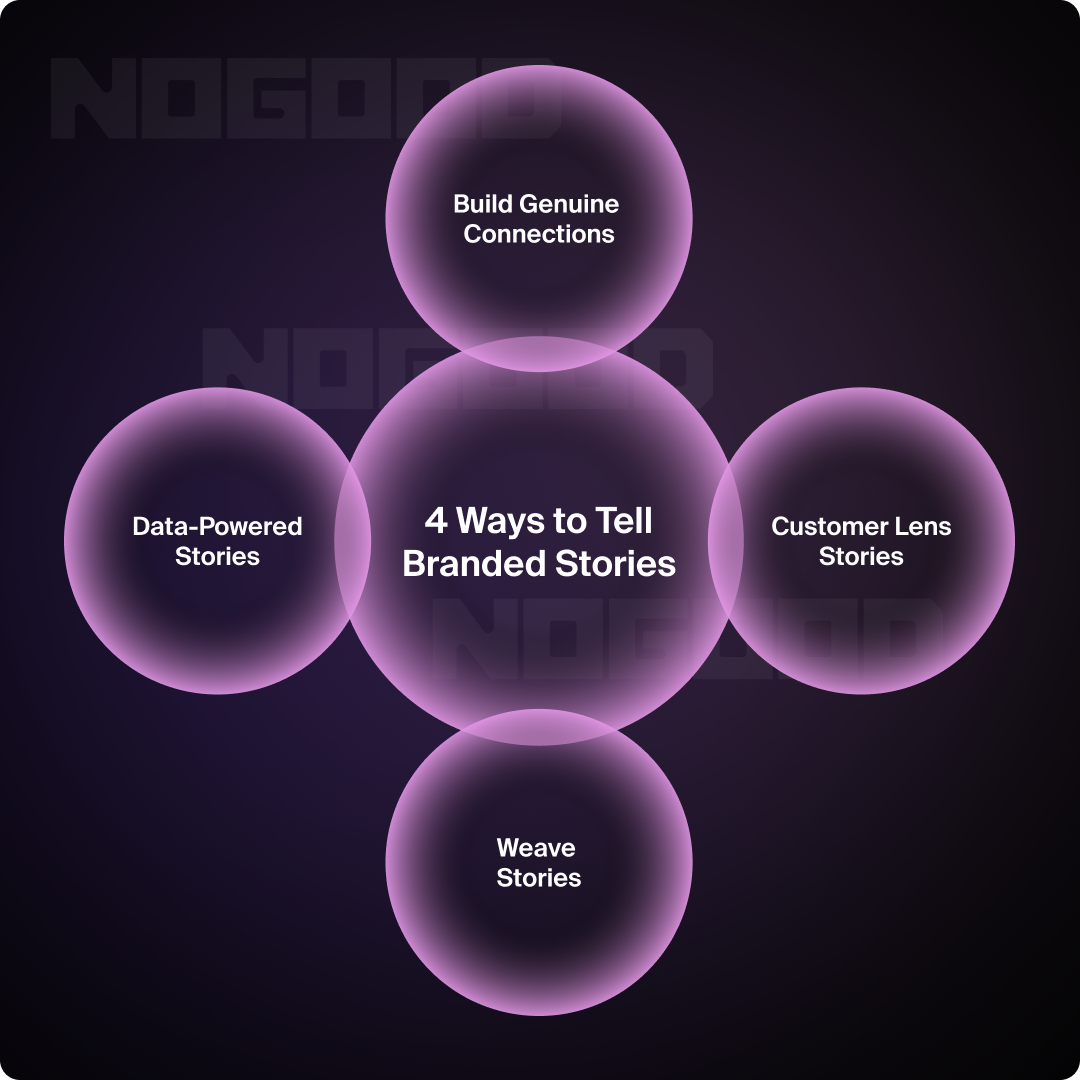News flash: your brand isn’t the main character. Your customer is.
The traditional marketing playbook we know and love is crumbling. The old formulas (polished ads, product placement jammed into every scroll, scripted influencer partnerships, etc.) just don’t work the same as they used to.
Why might that be? It’s plain and simple: consumers are growing tired of being sold to. Feeds are turning into ones that feel less like a place for connection and more like a storefront. Even algorithms, once designed to tailor content to our interests, have become thinly veiled marketplaces pushing whatever’s trending.
Enter narratives. A way to tell a story from a customer’s perspective that gives audiences a reason to stop the scroll. We’re seeing this in the rise of Substack writers, where audiences are craving that “slow burn” feeling. They’re carving out time for slower, more thoughtful consumption. And that same hunger for depth is shaping how people engage with brands, both online and offline.
That’s why we’re seeing the rise of branded content storytelling. It flips the script: it’s no longer about spotlighting a product, but about creating narratives that elevate a customer’s experience.
Building a branded content series (which we’ll get into later) takes this even further. Brands are finally discovering how to weave together stories that entertain, inspire, and resonate with their customers without their brand presence feeling overpowering.
But here’s the real question: do you know how to tell a story right?
What Is Branded Storytelling?
Weaving a clever narrative around your product doesn’t mean it’s good brand storytelling. It’s about re-centering your brand around the customer experience itself. When it reflects how customers feel, how they’re impacted, and what role your brand plays in their lives, that’s how your brand builds trust that can’t be bought.
We all know about the word authenticity. It was (and still is) a common buzzword. Dare I say, it’s been greatly overused. Every brand claims to be “authentic.” What was once a term that signaled “I’m genuine and real” now feels like a clear marketing tactic.
But today’s audiences are asking for something deeper: transparency. They want to see the imperfect moments and unfiltered truths that make a brand human. Transparency builds trust because it makes people feel like they’re being let in. It’s like inviting someone over to your house for dinner after meeting them once.
And when you combine transparency with narrative, you create emotional resonance. A story that mirrors an audience’s struggles, celebrates their wins, or reflects their aspirations is what hits close to home. And that emotional impact is what elevates branded storytelling above traditional advertising.
Traditional ads tell you what a product does. Branded storytelling shows you how a product or brand makes you feel. When brands successfully create a space where audiences see themselves in the narrative, they begin to trust them because their efforts feel transparent, not transactional.
Why It Matters:
- Builds Emotional Resonance: Narratives rooted in real-life experiences that trigger emotions like empathy or inspiration make audiences remember your brand long after the scroll.
- Creates Trust Through Transparency: When stories show honesty, vulnerability, and a peek into the human side of your business, brands gain trust and visibility without forcing product messages.
- Turns Customers Into Advocates: When a story resonates, customers don’t just consume. They begin to start conversations and spread your message organically to others.
4 Ways To Do Branded Storytelling Right
Not all stories are created equal. A narrative can be beautifully shot, well-written, or highly produced, but if it doesn’t land with your audience, it’s just noise that can easily be swiped past.
Success comes from understanding your audience, framing the story from their perspective, and using insights to turn real challenges and aspirations into compelling narratives.

1. Build Genuine Connections
Genuine connections go beyond clever campaigns; they tap into real human emotions and experiences. To build them, start by understanding your audience beyond FYPs and algorithms.
Show Vulnerability
Share moments that reveal the human side of your brand, no matter how “imperfect” it may be. Transparency is what makes a brand relatable and trustworthy. A brand that’s transparent or “authentic” doesn’t need to flaunt it in every video or page on its website.
Highlight Shared Experiences
Focus on stories that reflect your audience’s reality, celebrating their wins or empathizing with their struggles. When people see themselves in a story, the connection is almost immediate. And that prompts them to save and share them with friends.
Engage in Two-Way Communication
Connections can’t be one-sided. Try to encourage feedback and respond to comments when you can. From there, create content that invites participation so audiences can feel a sense of ownership in the story.
Consistency Builds Trust
Repeated exposure to stories that align with your brand’s values and the audience’s experience strengthens emotional bonds over time.
2. Tell Stories Through The Customer’s Lens
Your customer is the hero of your brand story, not you (sorry, not sorry!). By framing stories around their journey, challenges, and aspirations, you create narratives that feel personal and relatable.
- Empathize With Their Experience: Map out the moments where your audience struggles, celebrates, or seeks inspiration. These are the moments your story should amplify.
- Celebrate Wins, Not Products: Instead of spotlighting your product, showcase how it supports or enhances the customer experience. Give them the chance to feel like the protagonist in their own story.
- Use Real Voices: Incorporate testimonials, user-generated content (UGC), or interviews to make stories more authentic. Hearing peers’ experiences creates more believable narratives.
3. Use Data To Power Stories
Use customer data to your advantage. With properly crafted dashboards, you can understand your audience’s pain points, preferences, and behavior so you can craft stories that resonate.
- Identify Opportunities: Look for patterns in customer feedback, search behavior, or social sentiment to uncover topics that matter.
- Turn Insights Into Stories: Translate pain points into narratives of problem-solving, triumph, or growth. Then, show how your brand participates in those real-life experiences.
- Test & Iterate: Track engagement metrics to see which stories connect best with your audience. Data-driven storytelling allows you to refine your narratives over time for maximum impact.
4. Weave Stories Across Channels
If it needs to be stated, a great story loses its power if it’s fragmented or inconsistent. Consistency ensures that every touchpoint, from short-form to long-form content, reinforces the same narrative, voice, and emotional tone. This repeated exposure builds recognition over time, making your brand feel reliable against your competitors.
Consistency Matters
Ensure your story’s message and visual identity are aligned across all existing channels.
Tailor, Don’t Repeat
Adapt the story to each platform’s format while keeping the core narrative intact. A video should feel native to its respective channel but still be connected all throughout.
Create a Cohesive Experience
When audiences encounter your story across multiple channels, they should feel continuity rather than disconnection. Each touchpoint should build on the narrative and deepen their understanding and emotional connection with the story you’re trying to tell.
The Rise of Branded Content Series
Trends alone aren’t keeping users hooked anymore. Sure, the attention is there, but it’s fleeting. For years, brands were told to chase trends for relevance, but many forgot the real goal: relatability and connection.
Trends can be fun in the short term, but they rarely answer the bigger question: what perspective are you offering your audience? What unique story are you telling instead of following the crowd? The old playbook told brands to act like TikTok creators: keep it short, jump on memes, push out volume. That approach worked… until it didn’t.
Enter branded content storytelling (aka, branded content series). Brands are now building their own content universes and social shows. While creators once posted funny skits reminiscent of the Vine era, the format has evolved. Brands are adopting it in a way that feels natural, entertaining, and immersive, all without shoving their logo in viewers’ faces.
The shift is clear: we’re no longer just selling products; we’re sharing narratives. Brands are thinking less about which celebrity to endorse in their latest campaign and more about which character to create, what world to build, and who can act, write, or entertain.
But who? This ranges from creators to in-house employees. Merging two types of talent balances the execution: someone who turned their internet personality into a profession, and someone who knows exactly what the brand is.
Platforms like Instagram, TikTok, and YouTube favor these serialized, binge-worthy storytelling videos. That’s why we’re seeing writers’ rooms being created within marketing teams.
Content creators are the executors, but copywriters and creative strategists play a key role in embedding brand identity seamlessly into scripts, ensuring that stories feel natural while staying on-brand. The benefits are clear: higher engagement, longer attention spans, and stronger audience loyalty.
Common Mistakes to Avoid
However, even the most creative ideas can fall flat if branded content storytelling doesn’t land or if a series isn’t planned and executed with the right intentions. Small missteps, whether in tone, pacing, or audience alignment, can easily turn a compelling story into a missed opportunity with wasted effort. Here are some things to keep in mind:
1. Over-Branding
Pushing a product aggressively or attempting to squeeze it into every scene becomes obvious and makes your content feel more like an ad than a binge-worthy story. Whether you’re highlighting a product, service, or experience, the goal should be to integrate it naturally into the narrative so it connects seamlessly with your audience.
2. Lack of Transparency
If your content feels staged or disconnected from real customer experiences, trust can easily be lost. Telling a story through a content series needs to feel natural. That means writing scripts that make sense for both your brand and your customer, no matter how many versions it takes to get the story just right.
3. Starting Without a Narrative Arc
Random, one-off posts may grab attention momentarily, but fail to retain audiences without a coherent storyline. Writing storylines means an episodic series needs to either build off one another, carry a consistent message, or have a similar tone and vibe.
4. Ignoring Audience Insight
Failing to understand customer behaviors, needs, and values can make content irrelevant or tone-deaf. Try to use customer data to uncover their highs and lows, then translate those into your scripts. This makes content feel more relatable and relevant to their lives.
5. Inconsistent Delivery
Irregular posting and mismatched formats can weaken engagement. Be consistent with your posting cadence, whether it be every day or once a week; make it clear that customers can expect more. When audiences know the “next episode” is coming, they’ll have a reason to come back and tune in.
What Is a Brand Storytelling Example?
These examples show how different industries are experimenting with format, tone, and narrative to leverage branded content storytelling. They’re proof that you don’t need to be a media company to think like one.
Bilt
Bilt, the payment and rewards program for renters, launched a content series called Roomies. The main character, Ellie, is a girl who moved to New York from Ohio. In Roomies, she navigates having roommates and figuring out life while living in NYC for the first time.

The connection? Bilt and Roomies talk about renting. In an interview with “Link in Bio,” Bilt’s Senior Director of Content, Cyrus Ferguson, and Chief Marketing Officer, Zoe Oz, discuss playing the long game. They state that their members navigate through life transitions like “moving, renting, career changes, relationship shifts and Roomies explores exactly these themes through authentic storytelling.”
By talking about those universal experiences, viewers can connect with this series on a deeper level. They even take it a step further by setting the location in NYC, a place where rent is at an all-time high.
However, a reason why Roomies is so successful and stands out against other content series is that Bilt decided to separate its show from its brand account. Splitting the two allows for the show to shine on its own without the shadow of a branded profile picture.
With this move, Episode 1 of Roomies gained over 3 million views across channels and continues to see steady impressions. Across both Instagram and TikTok, they’ve gained over 150k followers. The goal behind this move was to invite attention, not demand it.
InStyle
InStyle is the infamous media brand known for its focus on pop culture, fashion, and beauty. This year, Season 3 of their show, The Intern, dropped. The first episode? Over 5 million views.
This series has a workplace comedy plot where InStyle searches for interns to join the company, poking fun at the stereotypes and quirks of interning at a fashion brand. It’s dramatic and funny; it doesn’t feel like a brand forcing the comedy angle. That humor comes naturally because of the character they chose.
InStyle chose influencers and creators to star in their series, bringing their built-in TikTok audiences over to the brand. These creators add their own personalities from their personal brands and blend it into InStyle’s scripts. With this, the acting looks and feels natural to viewers. Scripts don’t feel as rehearsed or stiff; often because parts are improvised, which plays to the creators’ strengths.
Cozy Earth
Cozy Earth is a luxury lifestyle brand known for selling home goods and quality bedding. Some would say they’re known for making their products with organic bamboo viscose. Others would know them for something more unexpected: the Bed Rot Challenge series.
Cozy Earth has turned its TikTok account into the stage for this viral competition, where contestants battle it out to see who can stay in bed the longest. The grand prize? $25,000. 10 contestants, 6 days, and a rotating lineup of over-the-top challenges from holding snakes to spiders in bed.

What makes this series so addictive is Cozy Earth’s commitment to the bit. It has the energy of shows like Wipeout or Ninja Warriors, but with a twist: competitive sleeping. Who said sleeping in can’t be a competitive sport, right? That’s what Cozy Earth plays with: the idea that good sleep can be rewarded, even if it means rotting in bed all day.
But what takes this series a step further is its immersiveness. Anyone within the US can apply to be a contestant in its Bed Rot Challenge series. Simply fill out an application, answer a few questions, submit a video about why you should be chosen, and the selected few get flown out (paid by Cozy Earth) to participate in their games.
Every challenge is recorded, posted on TikTok, and lets viewers follow along like a binge-worthy reality show. It gets users thinking to themselves, “guess what my ego says,” which prompts them to apply. The games may be scripted, but the contestants aren’t. By using real people, Cozy Earth creates a series that is uncut and unfiltered.
Takeaways for Brands Starting a Content Series
Great branded storytelling goes beyond selling products. Here’s what to keep in mind when leveraging branded content storytelling in marketing:
- Lead with story, not sales. The audience should feel entertained or inspired first, and be marketed to second.
- Tie in brand values. Make sure the narrative ties back to your brand’s mission or positioning in an authentic way without depending on logos to do the work for you.
- Leverage in-house copywriters. Create writers’ rooms to ensure brand identity and messaging are reflected accurately in scripts to execute in video.
- Repurpose content correctly. Cross-post your series, but adapt the format for each platform. Captions, thumbnails, and pacing should all match the expectations of the channel’s audience and algorithm.
- Measure what matters. Track engagement, sentiment, and audience insights to refine your storytelling and naturally weave in solutions or plot points.
- Collaborate for credibility. Partner with creators, experts, or communities that align with your brand’s story to add more hype to what you’re sharing.
By focusing on these principles, you’ll create a content series that not only captures attention but also builds lasting trust and loyalty with your audience, which is invaluable in today’s overcrowded market.







